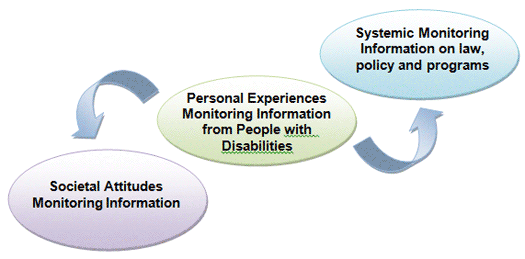Section 4.1 - Introduction to Holistic Reporting
A holistic monitoring report presents a comprehensive picture of the human rights of persons with disabilities living in a particular country. It involves pulling together individual interviews with information from one or two of the other monitoring areas - systemic or societal attitudes monitoring. This makes it possible to understand how rights guaranteed to persons with disabilities on the books become rights in their everyday lives.
DRPI’s approach to holistic monitoring makes the lived experiences of persons with disabilities central to tracking/monitoring rights. Personal stories are important in identifying the gap between laws, policies and programs on the books and how those impact people’s lives. They also provide an important way to understand the impact of societal attitudes on the exercise of rights.

The experiences of persons with disabilities are at the centre of the holistic report and bring together information from systemic monitoring and societal attitudes monitoring
What does the holistic monitoring report provide?
-
Filling the gaps between individual and systemic monitoring
- What are the promises?
- What is the reality?
- How is it possible to change so that the reality and the promises are the same?
- It gives voice to the way persons with disabilities live and the way in which they are able to enjoy their rights
- It links rights that governments and policy makers say people have and the everyday experiences of persons with disabilities
- It examines the impact that societal attitudes towards disability (reflected in media reporting) has on the exercise of rights
- It provides the information needed to start the conversation between government representatives and members of the disability community to develop laws, common policies and programs that are responsive to the human rights violations faced by persons with disabilities
- It emphasizes fact-based monitoring vs. impressionistic monitoring
